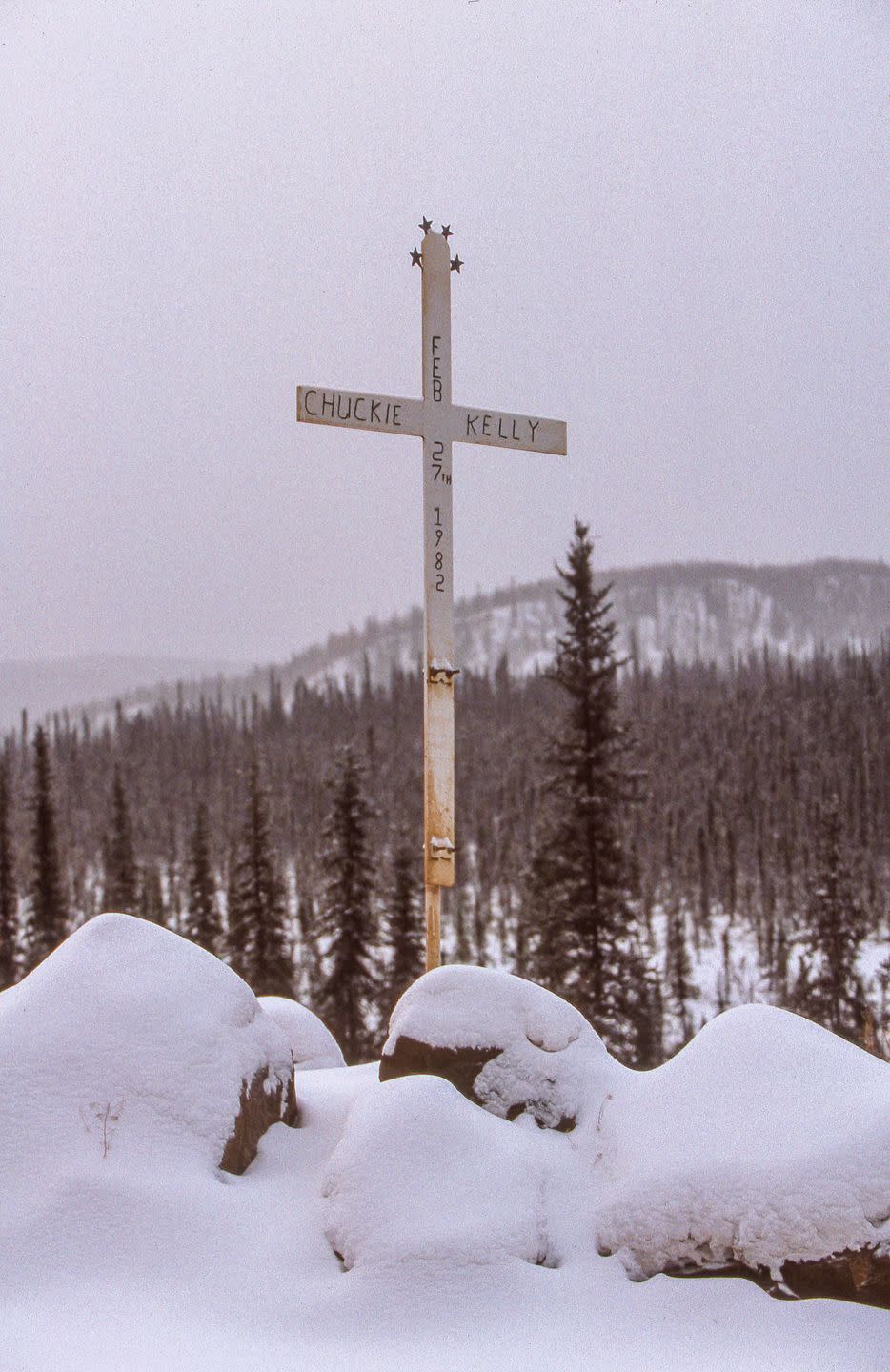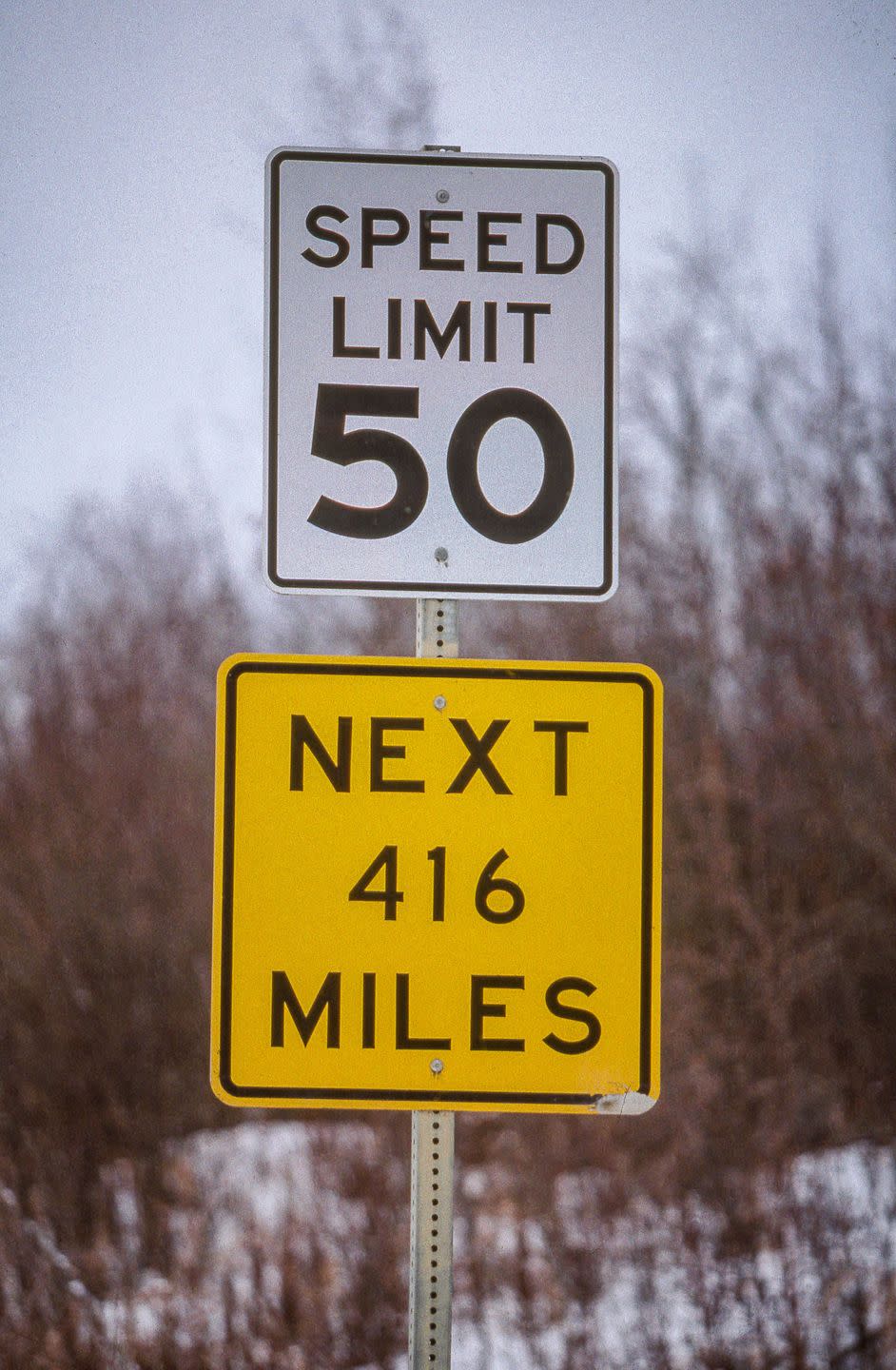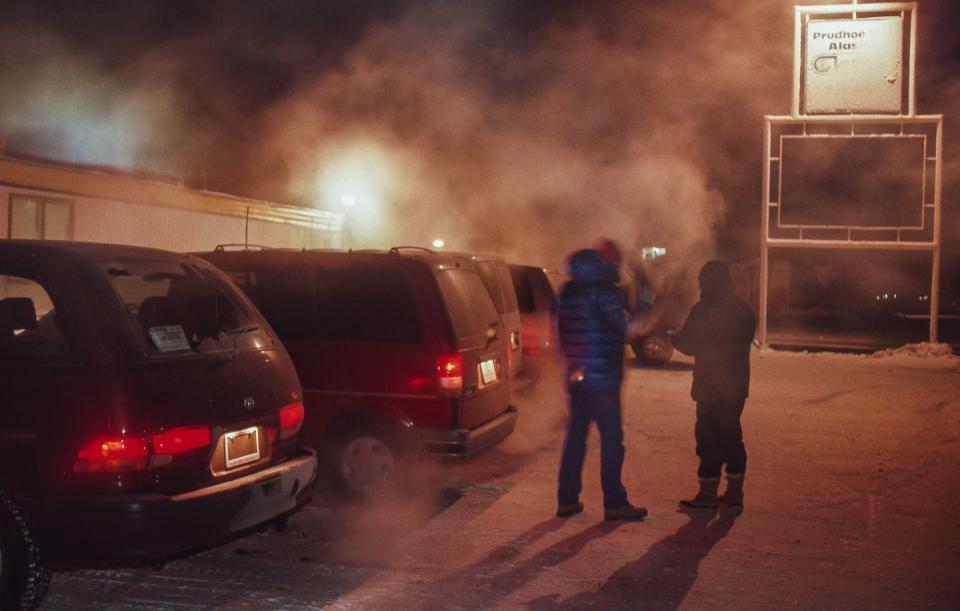Tested: Five 1992 4WD Minivans vs. Alaska's Dalton Highway

From the March 1992 issue of Car and Driver.
Alaskan's advice on driving the Dalton Highway in November: "Take spare windshields and tires. Take money. Take colorful clothes you can spread on the tundra to signal aircraft. Take Alaska Airlines south to Maui."
This came of course, after William Jeanes and Csaba Csere had warmly embraced the notion of driving the entire population of four-wheel-drive minivans as far north as possible on planet Earth.
William or Csaba came up with this idea before they knew anything about avalanches in the Brooks Range, grizzly-bear warnings, minus-40-degree temperatures, and four hours of daily sunlight. Before they heard that the 28-foot-wide Dalton Highway is entirely gravel, its 500-mile length punctuated by exactly two settlements that, on any given day, might or might not have fuel or electric lights or vegetarian lasagna. Before either knew we had to get permission from the state even to use the Highway—which is there to service the 800-mile-long trans-Alaska oil pipeline and not for motoring journalists, one of whom is carrying his sleeping bag in a brown paper sack that says, "Let's Go Krogering."
But by the time they'd learned enough to want to reconsider, it was too late. By then, five minivans, a GMC Yukon tow vehicle, and eleven people were already loitering in Fairbanks. (The Chevy Astro arrived via Federal Express. Really.) By then, C/D staffers were already grinding through stacks of reindeer sausage at the Westmark Fairbanks hotel, this despite warnings from our guides—John and Suzy Fouse—who had both arrived wearing tent-sized parkas and six inches of layered clothing that made them look like miniature submarines.

Alaskan veterans both, the Fouses had helped assemble the outpost whence the pipeline's oil emanates, which was also our destination: the otherworldly Prudhoe Bay, half on land and half atop the Arctic Ocean, a place that might have been a setting for Mad Max IV or Return of the Alien except that, as a backdrop for sci-fi movies, it is not sufficiently believable.
"It's warm here now," explains John Fouse as he gestures at Fairbanks's minus-15-degree weather. "But where we're going, it may get cold. And we only have an 18,000-pound winch on the Yukon."
Our heaviest minivan—the Astro—weighs 4449 pounds. So why a problem?
"Because you have the weight of the van added to the weight of what it's stuck in," he replies. "Which could be a chunk of the Brooks Range slightly larger than Alabama."
We set out anyway. Fouse ominously announces on the CB radio, "Gather up the wagons." (The Donner Party tried to cross the Sierra Nevada—a Wally Cox of mountain ranges compared with what we are facing—in wagons roughly the size of our own but without cruise control. A subject for Geraldo: People who have eaten people.)
Fifth Place: Chevrolet Astro

The Chevrolet Astro, which first appeared in 1985, constituted the General Motors reply to the enormously successful Chrysler minivans, Yet, if one looked closely at the Astro, one saw that it offered an entirely different atmosphere than the Chrysler people-haulers. The Astro was somehow more industrial, more trucklike.
This trucklike personality did not happen by accident. Whereas the Chrysler minivans were built to find a place in the family garage, the Astro was aimed at a dual target: the family garage and the workplace, GM frankly expected that its Astro would send more copies to the working world than to the softer demands of the suburbs, The Astro retains this duality of personality, not always to its advantage when compared with minivans that make commercial use a secondary goal, if it’s a goal at all.
At an as-tested price of $21,656, the Astro was our lowest-priced entry, though the range was intentionally narrow (the Caravan, at $22,104, was the most expensive). The Astro was the heaviest, by well over 200 pounds, but it was by far the most powerful. Its 4.3-liter V-6 pumped out 200 horsepower and 260 pound-feet of torque.
The Astro's commercial heritage is reflected in its dimensions: it was the tallest and widest of our vehicles, but missed by only one inch being the shortest. The rear-door design, side-by-side doors with small square windows in them also say "truck."
Put frankly, the Astro just didn't do very well on our test. Despite a power advantage, it wasn't the quickest, and despite a cargo volume that led the pack (152 cubic feet), the Astro would not hold the ubiquitous four-by-eight-foot sheet of plywood, and it had the least capacity for hauling lengths of pipe.
Tools were required to remove unwanted seats. What did work well was the Astro's all-wheel anti-lock braking system.
The Astro's poor finish was no doubt colored by an engine malfunction that still has us puzzled at deadline time. In Prudhoe Bay, we spotted oil drips, and then saw what appeared to be oil and water pumping out of the dipstick: normally a sure sign of failed head gaskets or loss of the separation between the oil and water systems. Stormin' Norman's Garage in Deadhorse allowed otherwise, "A seal," quoth Norman. Indeed, with extra oil aboard, we nursed the Astro back to Fairbanks, using only one quart of Mobil 1 in the process.
But there was more. This is not a new criticism, but this driver-side footwell is a feature that simply should never have been allowed to reach the consumer. In order to operate a modern vehicle, one should not find it necessary to hike one's left foot up on the wheel-well impingement in order to have room for the other foot on the floor. Size eleven, if you're curious.
Even assuming its engine malfunction to be unusual, our Astro just seemed out of phase with the rest. —William Jeanes
1992 Chevrolet Astro
200-hp V-6, 4-speed automatic, 4449 lb
Base/as-tested price: $17,790/$21,656
Cargo volume, seats in/out: 23/152 cu ft
C/D TEST RESULTS
60 mph: 10.3 sec
1/4 mile: 17.9 @ 76 mph
Braking, 70–0 mph: 204 ft
Roadholding, 300-ft-dia skidpad: 0.67 g
C/D observed fuel economy: 16 mpg
(continued)
A mere 30 miles north of Fairbanks, all traces of festering civilization conclude, even the neon Coors signs. One by one, the radio stations go dead. And there is a twenty-foot homemade white cross by the roadside, in memory of one Chuckie Kelly, who evidently erred here from the path of righteousness and the northbound lane. We are now officially On Our Own. Walk 50 feet off the Highway and you may well be standing in a spot just as it was 50 or 500 or 5000 years ago.
The Dalton Highway is narrow, and much of its loose granite surface—which is as sharp as Wilkinson sword blades and will soon chew up tires on both the Aerostar and the MPV—is mixed with coarse granular snow so dry and crunchy that it is like driving on dirt.

The road is named after James W. Dalton, a durable guy who was much in demand as an Arctic-construction expert after he directed the assembly of the DEW line for our Department of Defense. Construction of the highway—known originally simply as the Haul Road—began in 1974. The road crosses one third of Alaska and spans the state's highest mountain pass. Dalton did not leave the project in the hands of government. Here is the proof: the highway was completed in 154 days.
On this road—which has no stop signs, traffic lights, or no-passing zones for some 500 miles—there is room enough only for an eighteen-wheeler in the oncoming lane and a large accident in yours. Which we almost have as we meet our first southbound tanker, whose driver has evidently watched way too much pro bowling or is paralyzed at the sight of six civilian vehicles. He throws his rig into a 50-mph 18-wheel drift on an intercept guaranteed to demolish every minivan in our convoy. Then he gets off the brakes. Miraculously, the rig straightens and hurtles past in a hail of blue-white snow and granite shrapnel.
Two of the minivans' windshields are now cracked. All but the Previa's will be starred, scored, or spider-webbed by day's end. (Our motto: "It's only funny until someone loses an eye.") The Dalton Highway's rules of etiquette are different from ours. They do not apply on holidays, evenings, weekdays, and mornings. Also, there aren't any.
Guide Fouse, who evidently failed to see this feat of Third World driving, gets on the CB and repeats rules he mentioned at this morning's instructional:
1. Drink lots of water, because the humidity is only five percent and will fall as we get farther north.
2. Don't touch a door handle with your bare hands or a bumper with your tongue.
3. Assume the road beyond a hill or around a corner is entirely clogged with Peterbilt.
This time, nobody laughs.
Nor do they laugh at the next roadside sign, which bears a message we don't often see back home: SPEED LIMIT 50, NEXT 416 MILES.
Fourth Place: Toyota Previa All-Trac

As we prepared for our Alaskan onslaught, we questioned the inclusion of the Previa. Here was the lone four-wheel-drive minivan sold in the U.S. that offered no power choice other than its 2.4-liter in-line four-cylinder. Would it, we worried, stand up against minivans with V-6 power? In the end, we reasoned that it would be unfair not to include the Previa, for it was after all an all-wheel-drive minivan, and besides we were interested to see how its mid-mounted engine affected performance on snowy and icy roads. Would its favorable weight distribution overcome a horsepower deficit in hard winter use?
We should first define this horsepower deficit. The other competitors had engines with horsepower ratings ranging from 200 (the Astro) to 150 (the Caravan), with the other two providing 155 horse each. Thus, the Previa fell far below the Astro, but gave away no more than 17 ponies to the other three. Is this a lot of horsepower when it's Godzilla below zero and icy? You bet. But, as it turned out, the Previa was able to overcome the difference.
To arrive at a competitive price, $22,013 as tested, our Previa lacked a few creature features. It was the only vehicle fitted with roll-up windows, for example. Even in its stripper form, however, the Previa soon gained a following among the C/D explorer scouts.
The reasons for its popularity were subtle, yet pronounced. We've written before about the excellent design of the Previa's interior. This atmosphere, plus the excellent ergonomics within the cabin, plus seats that cradle you in an orthopedically responsible embrace, made the car just plain pleasant to occupy.
On the speed front, the Previa was the slowest of the quintet, but this consideration loses some steam when the roads are in a condition that lessens your desire to floorboard the throttle.
In normal use, if one can apply that term to Alaska driving, the Previa just did not seem underpowered enough to matter. At cruising speeds it was quiet, and on the utility front, it can carry an astonishing amount of luggage with its seats remaining in place. Removing its center seat requires tools, however.
The Toyota All-Trac system worked just fine on our 1100-mile excursion, though there's no provision for locking the center differential.
The operation of the Previa, aside from the lower horsepower, was superb. The ride was matched only by the Caravan for smoothness and comfort, and the four-wheel disc brakes (unique among our group) were unexcelled for performance.
As a measure of how well overall the Previa did, note that the Previa scored the highest of any minivan in styling (nine on a scale of ten), and that none of its competitors outscored it in handling, ride, ergonomics, comfort, or fun to drive.
In sum, we no longer doubt the Previa 's ability to compete in this company. —William Jeanes
1992 Toyota Previa All-Trac
138-hp inline-4, 4-speed automatic, 4092 lb
Base/as-tested price: $20,313/$22,013
Cargo volume, seats in/out: 23/147 cu ft
C/D TEST RESULTS
60 mph: 12.8 sec
1/4 mile: 19.2 @ 71 mph
Braking, 70–0 mph: 196 ft
Roadholding, 300-ft-dia skidpad: 0.71 g
C/D observed fuel economy: 17 mpg
(continued)
At mile 56 we cross the Yukon River, its surface an overlapping jigsaw puzzle of ice floes the size of the USS Vincennes and the same color. This is the fifth-longest river in North America and the point at which most summer tourists turn tail and make tracks back to Skinny Dick's Halfway Inn. The Yukon here is as wide as the Mississippi. It is spanned by a wooden-decked bridge 2290 feet long. To celebrate this crossing, Chris Jensen (a reporter for the Cleveland Plain Dealer and the only non-C/Der who inexplicably failed to say "no" when invited) inserts his Rinkbinders cassette so that we can sing the chorus to "The Yukon—She's Callin' Me Back." It is also Jensen who explains the lack of humidity to the liberal-arts majors: "See, any water in the air tends to get hard and fall on the ground. Gravity: it's a law we can live with."

We dismount here briefly to swap minivans. Nobody knows the temperature, but it nonetheless establishes conclusively that all those friends and neighbors who over the years have told you, "Once it gets below minus 15, it never really feels any colder," have never stood next to the Yukon River at sunset (3 p.m.) on November 20. The cold here is not just an annoyance, not merely a part of winter's quirky charm. It is a vital, physical force, a sucker punch in the solar plexus the moment you open a door.
In the time it takes to walk 50 yards from the Previa to a roadside plaque, the cold penetrates my two pairs of gloves and one pair of mittens, then forces its way through $240 worth of Vasque boots, two pairs of cotton socks, and a mismatched set of polypropylene boot liners. By then, my fingers are drunk. Grasping a pencil to take notes is difficult. (I had long since abandoned pens, whose ink ceased to flow even inside the minivans.) I am wearing a black rubberized face mask—apparel that tech editor Don Schroeder says resembles "some sort of medical device for persons with ruptures"—and when I remove it, a dime-size chunk of my iced mustache breaks off with it.
Alaska adventurer Joe McGinniss wrote: "In this sort of cold, you do not think of normal things—upset stomach, fatigue, financial problems, whether there was life after death. You were able to think only of the cold: it monopolized every facet of your being, like first love, or the news of a death in the family."

Yet it is here, hard on the banks of the rock-solid Yukon River, that one brave soul has dropped a few Alco aluminum boxes that double as a coffee shop. The cold has not frozen his sense of humor. A sign next to the entrance warns, "No shoe , no shirt, no service."
We do not know when or if we will eat during this trip, so associate editor Phil Berg has laden each minivan with giant freezer bag full of "survival gorp." This mix is created, he reveals, by combining pretzels, Wheat Chex, Rice Chex, Cheese Nips, peanuts, M&Ms, dried prunes, apricots, and bananas. He refuses to divulge the quantities of each, lest the recipe be widely copied. The banana and apricot stick to each other to resemble dried human ears and several less accessible body parts even more unappetizing.
Third Place: Mazda MPV

Travel light. The Mazda MPV was not the lightest of our group of five four-wheel-drive minivans. Its 4126 pounds is a whole person heavier—127 pound—than the Caravan, and 34 pounds more than the Previa. It's the most compact, however, so it forces you to pack slim.
The MPV was the shortest van in our group and had the least space for people in its second and third rows of seats. Luggage room is less than half that of the Toyota or Chevy with all the seats in place. Maximum capacity is only two-thirds that of the Toyota. So the MPV feels small and nimble, more like a car than any of the other minis except the Dodge. We like that feeling of a pint-sized van, but wish it involved less weight.
The 155-hp MPV accelerates less swiftly than the Chevy or the Ford and reaches a top speed of 105 mph, a bit shy of the less powerful Dodge. Still, the Mazda V-6 revs smoothly.

 Yahoo Autos
Yahoo Autos